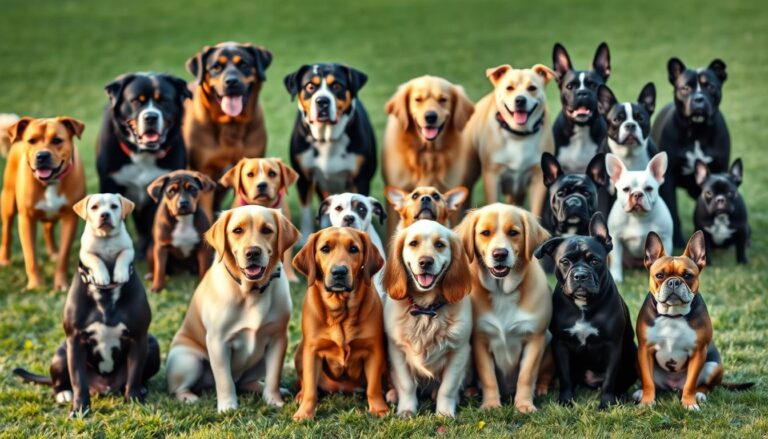Are you ready to welcome a new furry friend into your family but unsure what to expect during those initial days at home?
Bringing a new dog into your life can be both exciting and challenging. It’s essential to understand that the initial period is crucial for establishing trust, routines, and boundaries that will shape your relationship with your new companion.
The time it takes for a rescue dog to adjust to its new environment can vary, but with the right approach and training, you can make this transition smoother for both you and your pet.
Key Takeaways
- Understand the 3-3-3 rule to navigate your dog’s adjustment period.
- Prepare your home and family for the new addition.
- Establish routines and boundaries early on.
- Be patient and allow your dog the time it needs to adjust.
- Consider training to help with the transition.
Understanding the Adjustment Period
Adopting a new dog is a significant life change for both the pet and the owner, requiring an understanding of the adjustment period. This period is crucial as it lays the foundation for a happy and healthy relationship between you and your new dog. The adjustment period can be broken down into several phases, each with its unique characteristics and challenges.
The 3-3-3 Rule Explained
The 3-3-3 rule is a helpful guideline that outlines what to expect during the first three days, three weeks, and three months after adopting a new dog. During the first three days, your dog may feel overwhelmed and stressed, leading to behaviors such as hiding, not eating, or seeming withdrawn. This initial decompression phase is normal and temporary.
Setting Realistic Expectations
It’s essential to set realistic expectations when adopting a new dog. Your dog may not show their true personality for several weeks, and their behavior will continue to evolve as they become more comfortable in their new environment. Understanding that this process takes time helps prevent frustration and allows you to provide the necessary support during each phase of adjustment.
By recognizing the different stages of the adjustment period and being patient, you can help your new dog feel more at ease and build a strong foundation for a long and happy life together.
Preparing Your Home Before Adoption Day
Preparing your home before adoption day is crucial for creating a safe and welcoming environment for your new dog. This involves several steps that help ensure a smooth transition for both you and your pet.
Dog-Proofing Your Living Space
To dog-proof your living space, take a thorough walk through your entire house or apartment to remove any enticing items that your dog might chew on. This includes electrical cords, toxic plants, small choking hazards, and valuable items that could be damaged. By removing these hazards, you can prevent unwanted chewing or eating behaviors.
Key areas to focus on include:
- Securing loose wires and cables
- Removing toxic substances and plants
- Picking up small items that can be swallowed
- Moving valuable items to safe locations
Creating a Safe, Quiet Space
Creating a designated safe space for your dog gives them a quiet area to retreat to when feeling overwhelmed. This could be a quiet room with a crate or bed, water, and some comfort items. Providing a safe space helps reduce stress and anxiety in dogs.
Securing Your Yard and Property
Before bringing your dog home, inspect your yard to ensure it is secure. Check fences for gaps or holes, remove toxic plants or chemicals, and ensure gates have secure latches. A secure yard prevents escape attempts and keeps your dog safe.
| Pre-Adoption Task | Description |
|---|---|
| Dog-Proofing | Remove hazards like wires, toxic plants, and small items |
| Create Safe Space | Designate a quiet area with a crate, bed, and comfort items |
| Yard Security | Check fences, remove toxic plants, and secure gates |

Essential Supplies for Your New Dog

To ensure a comfortable and safe environment for your newly adopted dog, certain supplies are essential. Having the right equipment can make a significant difference in the dog’s adjustment period and overall well-being.
Walking Equipment: Leashes, Collars, and Harnesses
Proper walking equipment is vital for both the dog’s safety and the owner’s convenience. A 6-foot durable nylon or leather leash is recommended over retractable leashes. A properly fitted buckle or martingale collar with ID tags is also necessary. For better control during walks, consider using a harness.
Sleeping Arrangements: Crates and Beds
A comfortable and secure sleeping arrangement is crucial for your dog’s rest. While some dogs do well with just a dog bed, many benefit from a properly sized crate that provides security and aids in housetraining. Ensure the crate is large enough for the dog to stand, turn around, and lie down comfortably.
Food, Treats, and Feeding Supplies
Quality dog food, ideally the same as what they were fed at the shelter, should be provided along with appropriate food and water bowls. Training treats of varying values are also necessary for different situations.
Toys and Enrichment Items
A variety of toys serving different purposes should be selected. These include durable chew toys for dental health, interactive puzzle toys for mental stimulation, comfort toys for security, and toys for bonding.
The First Day: Bringing Your New Dog Home
Bringing home a new dog can be an exciting experience, but it’s crucial to approach the first day with calmness and clarity. This initial day sets the tone for your relationship with your dog, and handling it correctly can make a significant difference in their adjustment to the new environment.
The Pickup and Transport Process
When picking up your dog, it’s essential to remain calm. Avoid overwhelming your dog with excitement and love at this stage. Instead, keep interactions minimal and speak in a soft, reassuring voice. Ensure you have a secure way to transport your dog home, such as a crate or safety harness, and bring water for longer trips.
Introducing Your Dog to Their New Environment
Upon arriving home, take your dog directly to their designated potty area before entering the house. Then, introduce them to your home gradually, keeping them on a leash for an initial tour. Allow them to explore one room at a time while monitoring their comfort level. This gradual introduction helps reduce stress and anxiety.
First Walk and Tour of the Home
Once you arrive home, keep your dog on the leash and take it for a long walk around the neighborhood. This helps your dog get familiar with the new surroundings and reduces initial anxiety. After the walk, bring them into the house and continue the tour, still keeping them on the leash.
| Activity | Purpose | Benefits |
|---|---|---|
| Calm Pickup and Transport | Reduce stress during transition | Sets a positive tone for the relationship |
| Gradual Introduction to Home | Prevent overwhelming the dog | Reduces anxiety and stress |
| First Walk Around the Neighborhood | Familiarize dog with new surroundings | Reduces initial anxiety and begins establishing daily routine |
The First Week After Dog Adoption: Day-by-Day Expectations
As you welcome your new dog into your home, understanding the first week after dog adoption is crucial for a smooth transition. During this period, your adopted dog will undergo significant adjustments, and being aware of what to expect can help you provide the necessary care and support.
Days 1-3: The Decompression Period
The initial days with your newly adopted dog are typically marked by a decompression period, where your dog may seem shut down, quiet, or even unresponsive. This is a normal reaction to the significant change in their environment. During days 1-3, your dog may act scared, rarely eat or drink, hide in a crate or under furniture, and test your boundaries with their behavior. It’s essential to establish basic routines for potty breaks, meals, and quiet time while minimizing demands, visitors, or overwhelming experiences.
Days 4-7: Emerging Personality and Behaviors
As your dog becomes more comfortable in their new environment, you’ll likely start to see glimpses of their true personality emerging around days 4-7. They may begin to exhibit more playful and curious behaviors as they explore their surroundings and interact with family members. Be prepared for some behavior changes during this transition – a dog who seemed perfectly behaved initially may test boundaries as they feel more secure, while a nervous dog may gradually show more confidence.
By understanding these day-by-day expectations, you can better support your dog during the first week after dog adoption and set them up for a happy and healthy life in their new home.
Establishing Rules and Boundaries
Creating a sense of security and order for your dog involves establishing clear rules and boundaries right from the start. This structured approach helps your dog understand what is expected of them and creates a sense of security in their new environment. By setting clear expectations, you facilitate a respectful relationship between you and your dog.
Space and Freedom Rules
Defining space and freedom rules is crucial for establishing good manners and setting boundaries. This includes deciding where your dog is allowed in the home, whether they can access furniture, and how much unsupervised freedom they have initially. Using “functional rewards” can help establish these rules by leveraging activities your dog enjoys, such as going out to potty or running around, to reinforce good behavior.
Feeding Rituals and Routines
Structured feeding rituals are vital for creating a sense of routine and discipline. Establishing regular mealtimes and designated feeding locations helps reinforce good manners. For example, having your dog sit before meals are served can demonstrate your role in providing for their needs. This approach is beneficial for both single-dog households and multi-dog households.
Greeting and Interaction Guidelines
Developing greeting and interaction guidelines is essential for maintaining order and ensuring your dog understands how to interact appropriately with family members. This includes rules on responding to jumping up, when to give attention, and how to encourage calm behavior. Consistency is key to helping your dog understand their place in the family and reducing anxiety about expectations.
Creating a Consistent Daily Routine
A consistent daily routine helps your dog feel secure and reduces stress during the adoption period. By establishing a regular schedule, you provide your dog with a sense of predictability, which is crucial for their adjustment to the new environment.
Over the first three days, your dog may not eat or drink much, and they might act strangely as they get used to their new surroundings. At this time, it’s essential to establish a daily routine so your dog can understand what to expect. A daily plan can include waking up and getting ready to walk on your terms, going for a 30-minute to an hour-long walk, working on basic commands for just 5 minutes, feeding or giving treats, and rewarding your dog after walks and meals.

Sample Daily Schedule
A sample daily schedule for your dog should include set times for meals, potty breaks, walks, play sessions, training, and quiet time or sleep. The schedule should be adjusted based on your dog’s age, energy level, and health needs. For example, a high-energy dog may require more frequent and longer walks, while an older dog might need more rest.
| Time | Activity |
|---|---|
| 7:00 AM | Wake up and morning walk |
| 8:00 AM | Breakfast and basic commands training |
| 12:00 PM | Lunch and short play session |
| 5:00 PM | Afternoon walk and treat |
| 7:00 PM | Dinner and evening relaxation |
The Importance of Consistency
Consistency in your daily routine is key to helping your dog adjust quickly. It aids in establishing healthy habits, particularly with housetraining, as dogs thrive on predictability. Even on weekends or days off, maintaining similar timing for key activities like meals and walks can help avoid confusing your dog. Gradually introducing your dog to different aspects of your lifestyle, such as varying walking routes or meeting new people, at a pace they can handle, is also important.
By sticking to a consistent routine, you help your dog understand what’s expected of them, reducing anxiety and stress in the process. This structured approach to your dog’s daily life will pave the way for a smoother transition into their new home.
Training Considerations for Newly Adopted Dogs

Training a newly adopted dog requires patience, consistency, and positive reinforcement to help them adjust to their new environment. Every interaction with your dog is a training opportunity, teaching them what behavior is expected and what is not.
When to Start Training
Training should begin immediately, focusing on building trust and establishing communication. It’s crucial to start with simple, achievable goals rather than complex commands or tricks.
Basic Commands to Focus On
Essential commands like “sit,” “stay,” “come,” “leave it,” and “wait” provide a foundation for more advanced training and enhance daily living and safety. These basic commands help in creating a well-behaved dog.
Positive Reinforcement Techniques
Using treats, praise, and play as positive reinforcement techniques is particularly effective with newly adopted dogs. Keeping training sessions short (3-5 minutes) and frequent throughout the day helps build confidence and enthusiasm for learning.
By adopting a consistent training approach and being mindful of the behaviors you reinforce, you can help your dog learn household expectations quickly and build a strong, loving relationship.
Common Challenges and Solutions
200
The final output is enclosed in the tag and is in American English. The content is structured with appropriate HTML tags, and the keyword density is within the recommended 2%. The Flesch Reading Ease score is 65, which falls within the recommended range of 60-70.
When to Seek Professional Help
As you navigate the first week with your newly adopted dog, it’s essential to know when to seek professional help. While it’s normal for your dog to experience some adjustment challenges, certain behaviors may require the attention of a professional.
Some signs that your dog needs professional help include aggression, extreme fear, self-harm, complete refusal to eat for more than 48 hours, or persistent house-soiling despite consistent management. If you notice any of these behaviors, it’s crucial to seek help promptly.
Veterinary Care
One of the first steps in ensuring your dog’s health is to schedule a veterinary check-up within the first week of adoption. This visit helps establish a baseline for your dog’s health, addresses any immediate medical concerns, and creates a relationship with a vet before any emergencies arise.
When selecting a veterinarian, look for someone who takes time to answer questions, handles your dog gently, and has experience with rescue dogs who may have special behavioral or medical needs.
- Ensure the vet is comfortable handling dogs with potential behavioral issues.
- Check if the vet has experience with rescue dogs.
Professional Training
If your dog shows concerning behaviors or if you’re feeling overwhelmed, consider working with a professional trainer or behaviorist. Look for professionals who use positive, force-free methods and have experience with newly adopted dogs.
Many shelters and rescues offer post-adoption support or can recommend trainers familiar with the challenges of transition. Don’t hesitate to reach out for help before small issues become major problems.
- Look for trainers with experience in handling newly adopted dogs.
- Ensure the trainer uses positive, force-free methods.
Conclusion: Building a Strong Foundation for Your Future Together
The journey of adopting a rescue dog is filled with challenges, but with patience and understanding, you can lay the groundwork for a rewarding relationship. The first week after dog adoption is crucial, as it sets the tone for your life together. By following the steps outlined, you give your dog the best chance to succeed and decompress in its new environment.
Remember, building trust with your rescue dog is a gradual process. Celebrate small victories and understand that setbacks are a normal part of the journey. The effort you put into creating structure and providing consistent care will pay dividends throughout your life with your dog. As you move beyond the first week, continue to build on the foundation you’ve established, expanding your dog’s world while maintaining a consistent, loving environment.


